Let me share my favorite kitchen experiment that turned into a family hit. You know how we Filipinos love our adobo and humba, right? Well, one day I only had chicken in the freezer but was craving the sweet-savory taste of humba. Instead of running to the store, I thought, "Why not combine these two?" The result? This super sarap Chicken Adobo ala Humba that my family now requests every week.
What makes this recipe special is how simple it is - just regular ingredients from your kitchen but with a twist. The chicken gets tender in the classic adobo sauce, but the star anise and fresh pineapple give it that humba magic.
Don't worry if you're a beginner cook, this recipe is as easy as cooking regular adobo. But trust me, the flavor will make everyone think you spent hours in the kitchen. Try it once, and I bet it'll become your new favorite way to cook chicken!
Jump to:
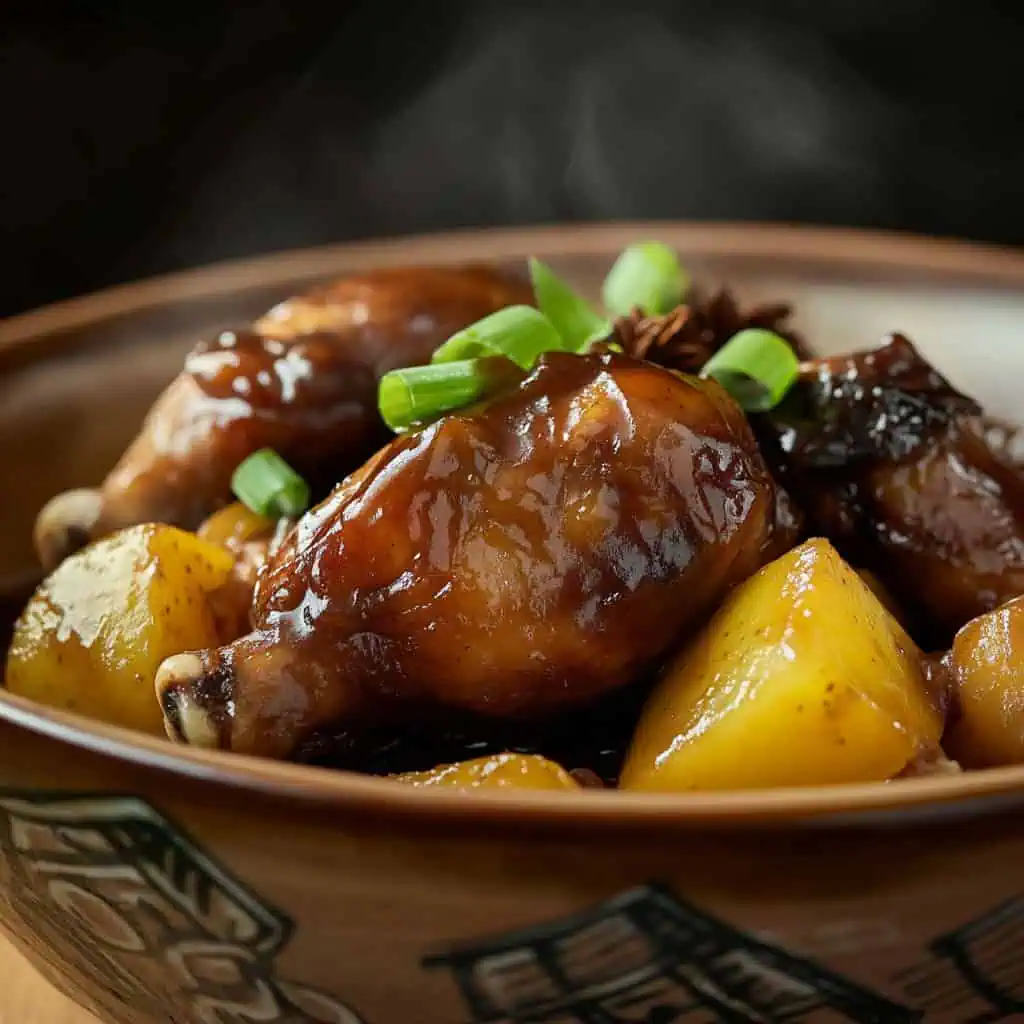
Why You'll Love This Recipe
- Perfect balance of savory and sweet flavors
- Healthier twist on traditional pork Humba
- Uses fresh ingredients for better taste
- One-pan cooking for easy cleanup
- Budget-friendly family meal
- Great for meal prep and leftovers
Ingredients
This recipe carefully combines ingredients from both adobo and humba traditions to create something truly special. The chicken provides a lighter alternative to traditional pork humba while still absorbing all the rich flavors. Soy sauce and vinegar form the classic adobo base, creating that perfect tangy-savory foundation.
Star anise adds the distinctive aromatic quality that makes humba unique, while fresh pineapple brings natural sweetness and tenderizing enzymes that help create exceptionally juicy meat. Potatoes soak up the flavorful sauce and add heartiness, while garlic provides that essential Filipino flavor profile. The optional rice wine adds depth, but the dish remains delicious without it.
Each ingredient serves a purpose, working together to transform two beloved classics into one extraordinary meal that's both familiar and excitingly new.
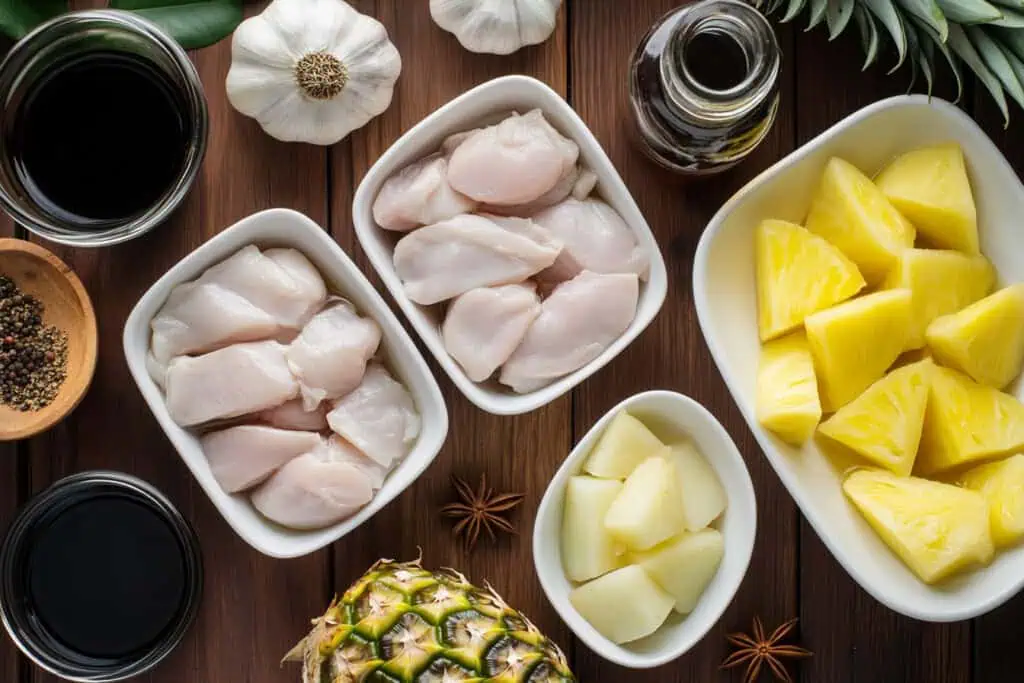
- ½!-- /wp:list-item -->
- ⅓ cup soy sauce
- ¼ cup white vinegar
- 2 small potatoes, sliced
- 6-8 cloves of garlic, chopped
- 1 cup fresh pineapple chunks
- 1 small star anise
- 1 bay leaf or dried oregano
- 1 tablespoon sugar
- ¼ teaspoon ground pepper
- ½ cup water
- 1 tablespoon Chinese rice wine (optional)
- Cooking oil for browning
Equipment
- Large heavy-bottom pan or kawali: Provides even heat distribution for proper browning and cooking
- Sharp knife: Essential for cutting chicken and vegetables cleanly
- Cutting board: Necessary for safe food preparation
- Measuring cups and spoons: Ensures recipe accuracy
- Wooden spoon or spatula: Allows for sautéing without scratching your cookware
- Tongs: Helps with safely turning and handling hot chicken pieces
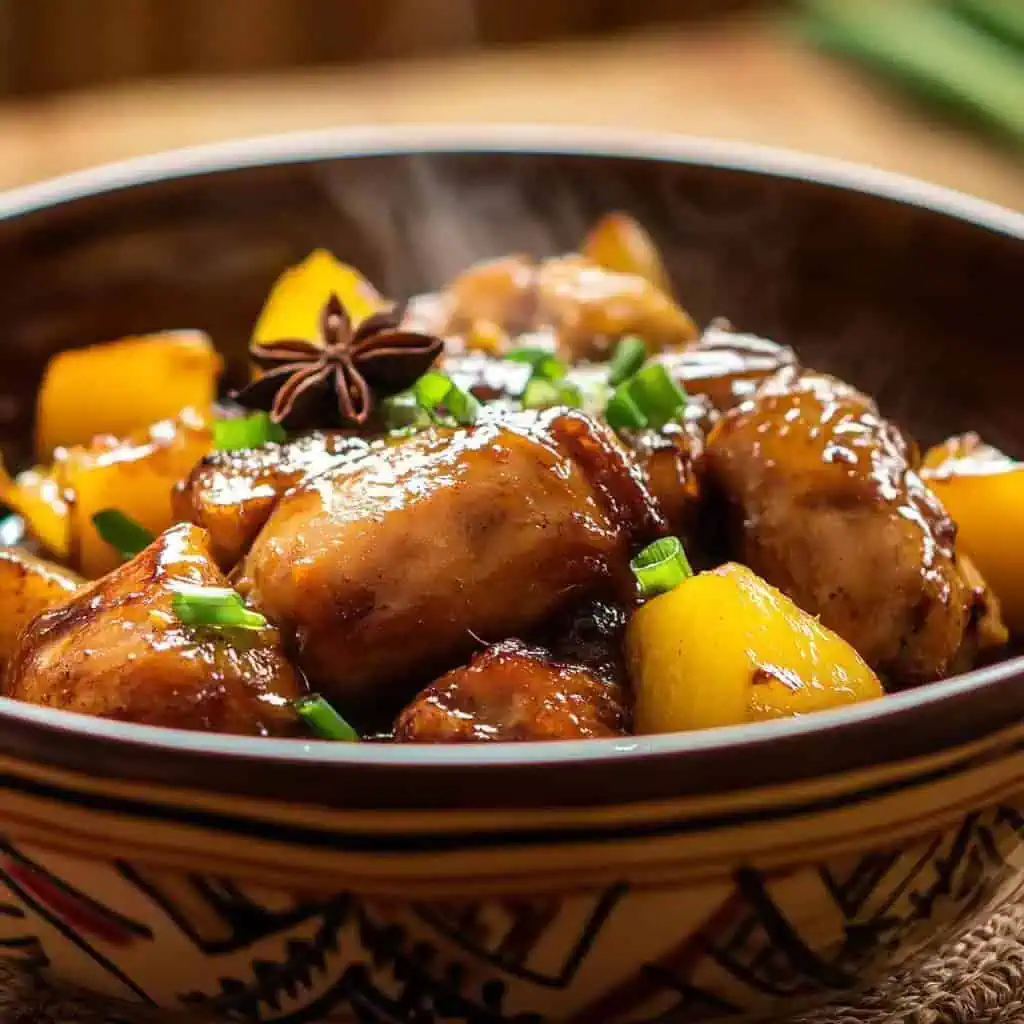
How To Make
- Heat oil in a large pan over medium-high heat. Once hot, add the chicken pieces and brown them on all sides until golden, about 3-4 minutes per side. If using Chinese rice wine, drizzle it over the chicken and let it absorb.
- Add the chopped garlic to the pan with the chicken and cook until golden and fragrant, about 1 minute. Add the sliced potatoes and cook with the chicken and garlic for another 2-3 minutes.
- Pour in the soy sauce and vinegar, but don't stir yet. Let the vinegar evaporate for about 2 minutes. This prevents the sauce from becoming bitter.
- Add the star anise and bay leaf, then pour in the water. Lower the heat, cover the pan, and simmer gently for 15-20 minutes until the chicken and potatoes become tender.
- Once the chicken is fully cooked, stir in the sugar, and add salt and pepper to taste. The chicken is done when it's no longer pink inside and the potatoes are tender when pierced with a fork.
- Add the fresh pineapple chunks to the pan. Cover and let simmer for just 1-2 minutes more to warm the pineapple through while keeping it fresh.
- Turn off the heat and let the dish rest for 5 minutes before serving. This resting time allows the flavors to settle and the sauce to thicken slightly. Serve hot over steaming white rice.

Tips from Lola's Kitchen
- Marinate the chicken in soy sauce, garlic, and pepper for 30 minutes before cooking for deeper flavor penetration
- Take your time with the browning process—this builds essential flavors that form the foundation of the dish
- Never stir immediately after adding vinegar; letting it evaporate first prevents a bitter aftertaste
- Fresh pineapple contains natural enzymes that help tenderize the meat while adding brightness
- For a thicker, more concentrated sauce, remove the lid and simmer uncovered during the final 5 minutes
- Always taste before serving and adjust seasonings if needed—balance is key in Filipino cooking
- Cut chicken pieces in similar sizes to ensure even cooking throughout
Substitutions
- Chicken: Thighs or wings can be substituted for more flavor and moisture; boneless skinless thighs work especially well
- Pineapple: Canned pineapple chunks work in a pinch (drain well first); reduce added sugar if using canned
- Soy sauce: Light soy sauce provides a cleaner taste; coconut aminos work for a gluten-free option
- Star anise: Use ¼ teaspoon Chinese five-spice powder if star anise isn't available
- Bay leaf: Dried oregano or thyme can provide a similar aromatic quality
- Rice wine: Dry sherry makes a good substitute, or simply omit it entirely
- Sugar: Brown sugar or coconut sugar can add more depth of flavor
- Vinegar: Apple cider vinegar can be used instead of white vinegar for a slightly different flavor profile
Troubleshooting
- Sauce too thin? Remove the lid and simmer uncovered for 5-10 minutes to reduce and concentrate flavors
- Chicken too tough? Lower the heat and cook longer with more liquid, or next time use chicken thighs instead of breast
- Too salty? Add a quartered potato to absorb excess salt, then remove it before serving; also add a little more water
- Too sour? Balance with a bit more sugar, starting with half a teaspoon at a time
- Sauce too sweet? Add a splash of vinegar to restore the balance
- Bland taste? Add a teaspoon of fish sauce for umami depth without making it saltier
Storage & Reheating
- Refrigeration: Store in an airtight container for up to 3 days. The flavors actually improve overnight!
- Freezing: Can be frozen for up to 2 months in freezer-safe containers. Thaw overnight in refrigerator before reheating.
- Reheating on Stovetop: Place in pan over low heat with a splash of water to prevent drying out. Heat gently until warmed through.
- Microwave Reheating: Heat on medium power for 2-3 minutes, stirring halfway through. Cover loosely to prevent splattering.
- Serving After Storage: A fresh garnish of sliced green onions can revitalize the dish after reheating.
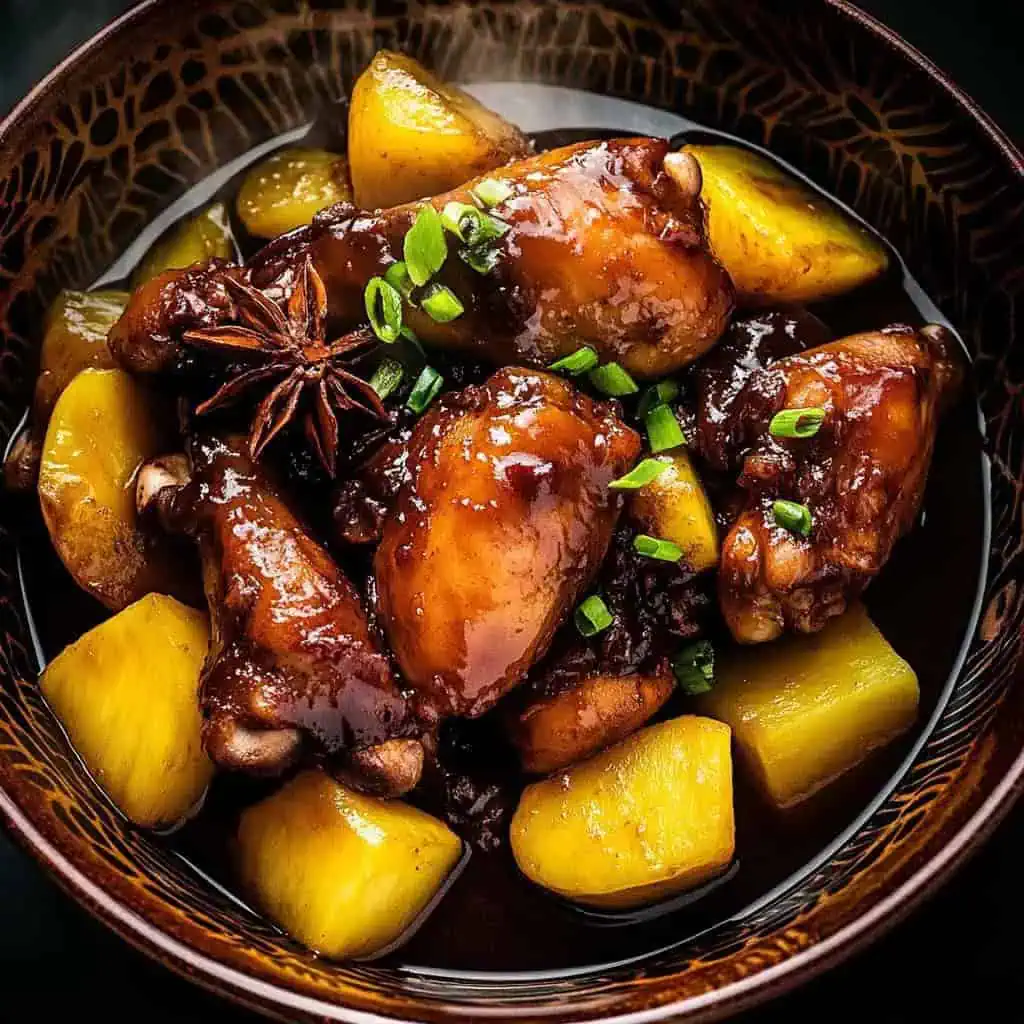
FAQ
Can I make this in advance for a party?
Yes! The flavors actually develop and improve overnight. Make it a day ahead, refrigerate, and gently reheat before serving.
Why can't I stir right after adding vinegar?
This cooking technique prevents the vinegar from becoming bitter and allows proper evaporation, creating a more balanced sauce.
How do I know when the chicken is done?
The internal temperature should reach 165°F (74°C), or you can cut into the thickest part—the meat should be white throughout with no pink.
Can I use bone-in chicken?
Absolutely! Adjust cooking time to 25-30 minutes to ensure the chicken cooks completely. Bone-in pieces often have more flavor too.
Is this recipe spicy?
No, this version is not spicy, but you can add bird's eye chilies (siling labuyo) or chili garlic sauce if you prefer some heat.
Can I make this in a slow cooker?
Yes! Brown the chicken first, then transfer everything to a slow cooker and cook on low for 4-5 hours or high for 2-3 hours.
How can I make the sauce thicker?
For a naturally thickened sauce, simmer uncovered for the last 10 minutes. Alternatively, you can make a slurry with 1 teaspoon cornstarch mixed with 1 tablespoon water and stir it in during the final minutes.
Can I add vegetables to make it a complete meal?
Definitely! Bell peppers, carrots, and baby corn are excellent additions. Add firm vegetables with the potatoes and quick-cooking ones in the last 5 minutes.
Related
Looking for other recipes like this? Try these:
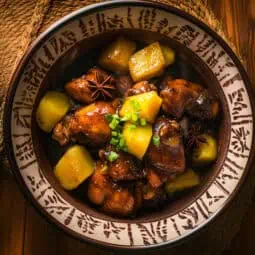
Chicken Adobo ala Humba Recipe
Equipment
- Large heavy-bottom pan or kawali (Filipino wok) For even heat distribution and proper browning
- Sharp knife (kutsilyo) For cutting chicken and vegetables
- Cutting board (Sangkalan) For preparation
- Measuring cups and spoons (Panukat) For accurate measurements
- Wooden spoon or spatula For sautéing without scratching the pan
- Tongs For handling the chicken pieces
Ingredients
- ½ kg chicken breast fillet or any chicken parts
- ⅓ cup soy sauce toyo
- ¼ cup white vinegar suka
- 2 small potatoes patatas, sliced
- 6-8 cloves of garlic bawang, chopped
- 1 cup fresh pineapple chunks pinya
- 1 small star anise sangke
- 1 bay leaf dahon ng laurel or dried oregano
- 1 tablespoon sugar asukal
- ¼ teaspoon ground pepper paminta
- ½ cup water tubig
- 1 tablespoon Chinese rice wine optional
- Cooking oil for browning mantika
Instructions
- First, heat oil in a large pan over medium-high heat. Once hot, add the chicken pieces and brown them on all sides until golden, about 3-4 minutes per side. If using Chinese rice wine, drizzle it over the chicken and let it absorb.
- Add the chopped garlic to the pan with the chicken and cook until it becomes golden and fragrant, about 1 minute. Put in the sliced potatoes and cook them with the chicken and garlic for another 2-3 minutes.
- Pour in the soy sauce and vinegar, but don't stir yet - this is important. Let the vinegar evaporate a bit, which takes about 2 minutes. This prevents the sauce from becoming bitter.
- Add the star anise and bay leaf (or dried herbs), then pour in the water. Lower the heat, cover the pan, and let everything simmer gently for 15-20 minutes. The chicken and potatoes should become tender during this time.
- Once the chicken is fully cooked, stir in the sugar, and add salt and pepper to taste. The chicken is done when it's no longer pink inside and the potatoes are tender when pierced with a fork.
- Finally, add the fresh pineapple chunks to the pan. Cover and let it simmer for just 1-2 minutes more - you want the pineapple to warm through but still stay fresh and bright.
- Turn off the heat and let the dish rest for 5 minutes before serving. This resting time lets the flavors settle and the sauce thicken slightly. Serve hot over steaming white rice.
Tips from Lola's Kitchen
- Marinate chicken for 30 minutes before cooking for extra flavor
- Don't rush the browning process - it builds essential flavor
- Let the vinegar evaporate before stirring to avoid a bitter taste
- Fresh pineapple contains enzymes that help tenderize the meat
- For thicker sauce, simmer uncovered during the final 5 minutes
Nutrition
The Story Behind Chicken Adobo ala Humba
As a home cook who loves experimenting in the kitchen, I discovered this recipe during one of those "what's in the pantry?" moments that every Filipino can relate to. You see, traditional humba from Visayas is usually made with pork belly and black beans, slow-cooked until the meat falls apart. Meanwhile, chicken adobo is that everyday dish we all grew up with – the unofficial national dish of the Philippines that every region has its own version of.
One busy weekend, I was craving the sweet-savory taste of my mother-in-law's Cebuano humba but only had chicken in the freezer. Instead of running to the market, I thought about how both dishes share similar base flavors - soy sauce, vinegar, and garlic. That's when it hit me: why not combine these two beloved dishes? The star anise and pineapple from humba could add an exciting twist to classic adobo.
What started as a simple kitchen experiment turned into a family favorite. The fresh pineapple adds a natural sweetness that reminds me of humba's traditional touch of sweetness, while the star anise brings that distinct Asian flair that makes everyone ask, "What's that interesting flavor?" Unlike traditional humba that needs hours of cooking, this chicken version is ready in just 45 minutes – perfect for busy parents who want to serve something special on weeknights.
This recipe has become my potluck party secret weapon. Every time I bring it to family gatherings or town fiestas, people are surprised to learn it's not traditional humba or adobo. It's become such a hit that my aunt in Cebu now makes it for their Sunday family lunches, proving that sometimes the best recipes come from happy accidents in the kitchen.
By combining two beloved Filipino dishes, this recipe shows how our cuisine continues to evolve while keeping its soul. It's a testament to how Filipino home cooks can be creative with traditional recipes, making them work for modern lifestyles without losing that comforting taste of home.
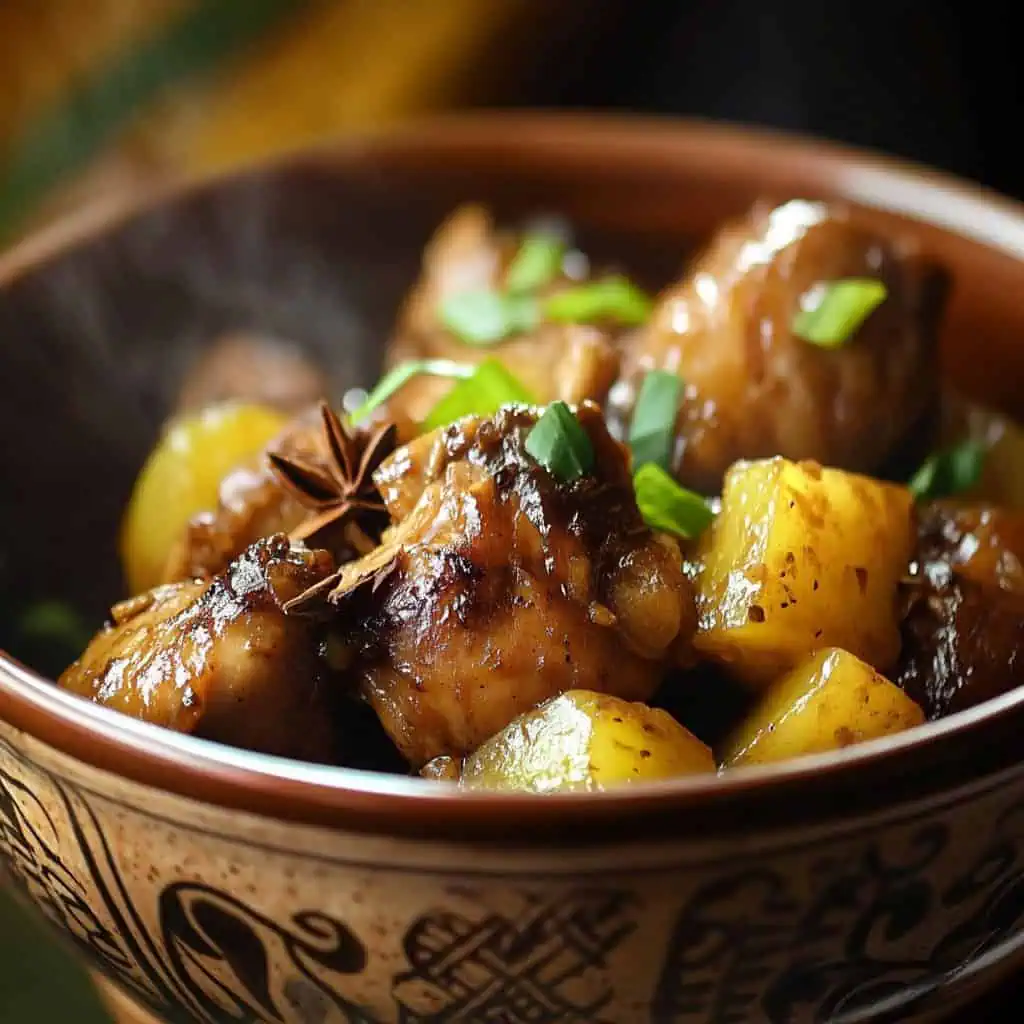








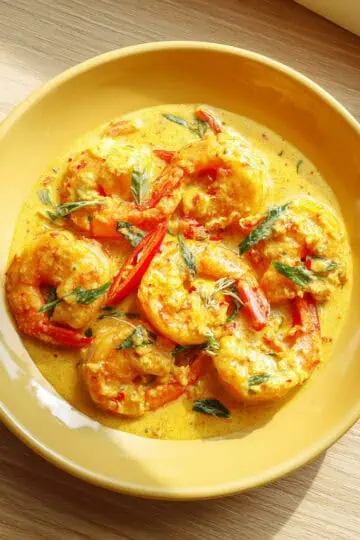
Comments
No Comments